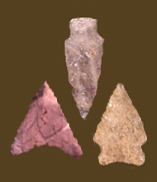
HOW ARE POINTS USED? Native Americans used projectile points as tips on their lances, spears, darts, and arrows, all weapons used primarily for hunting, occasionally fishing, and sometimes combat. When propelled with sufficient force, the sharp tip and edges of a projectile point could penetrate the hide of an animal. The substantial amount of animal bone found at Native American sites is clear evidence of their hunting prowess and the effectiveness of their weapons. Some lances, spears, and arrows had a detachable foreshaft, a short piece of wood or bone tipped with a projectile point that fit into the larger wooden shaft. A foreshaft allowed the hunter to disconnect the shaft once the point on the foreshaft was imbedded in an animal. Foreshafts also served as knifes. Using a projectile point as a knife, Native American hunters could butcher the carcass of an animal to transport smaller packages of meat back to a village or camp. Narrow projectile points were used as awls or drills for penetrating hide, wood, bone, and stone.
Photo credit: http://georgiainfo.galileo.usg.edu/gastudiesimages/Woodland%20Indians%20Hunting%20Deer.jpg |
![]()
Search by Shape:
(See Projectile Point Typology) |

|
Thank you for visiting our website. If you have any
questions, comments, Copyright © 2002 by |

|

